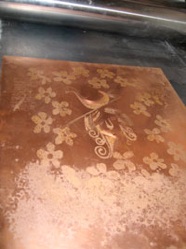Etching, the art of engraving with acid on metal; also the print taken from the metal plate so engraved. In hard-ground etching the plate, usually of copper or zinc, is given a thin coating or ground of acid-resistant resin. This is sometimes smoked so that lines scratched through the resin will be clearly visible. A needle exposes the metal without penetrating it. When the design is completed, the plate is submerged in an acid solution that attacks the exposed lines. During the bath the plate is frequently removed, and such lines as are bitten to sufficient depth are coated with stopping-out varnish. The lines receiving the longest exposure to the acid will be the heaviest and darkest in the print. It is also possible to apply the acid locally to the plate. In printing, all varnish is removed; the plate is warmed, coated with etcher's ink, and then carefully wiped so that the ink remains in the depressions but is largely or wholly removed from the surface. It is then covered with a soft, moist paper and run through an etching press. There are many variations in the technique of etching. Etchers often remove undesired lines by burnishing and otherwise change the first state of the plate from which they make their trial print. Certain etchings appear in many and widely differing states. Only a limited number of first-rate proofs can be made from a plate, and some etchers destroy their plates after making a given number of prints. Soft-ground etching gives effects similar to those obtained in pencil or crayon drawing, while aquatint approximates the effects of a wash drawing. Aquatint is often combined with hard-ground etching, as is also drypoint. This latter technique is not true etching, as no acid is employed; drypoint produces a finer line than does aq¬¬uatint. Pictorial etching evolved gradually from the earlier burin engraving. Both seem to have originated in Germany, where Dürer's etchings on iron, made between 1510 and 1520, were probably the earliest important examples of an art that in the following centuries was practiced by many of the greatest draftsmen and painters. Among the foremost in the history of etching are the works of Dürer, Callot, Rembrandt, the Tiepoli, the Piranesi, Goya, and Whistler.
See A. M. Hind, A History of Engraving and Etching (rev. ed. 1963); J. Pennell, Etchers and Etching (1919); A. Gross, Etching, Engraving, and Intaglio Printing (1970); W. Chamberlain, The Thames and Hudson Manual of Etching and Engraving (1978).


